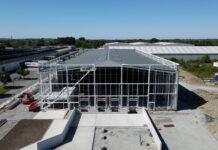
WHILE Limerick is a long-established and proven location for international business, it is also Ireland’s most future-focused city, committed to innovation and economic growth.
The beating heart of Ireland’s Mid-West is investing over €1 billion in enterprise and investment infrastructure as part of the ‘Limerick 2030 Vision: An Economic and Spatial Plan for Limerick’, a 20-year action plan which aims to transform Limerick through the economic, social and physical renaissance of Limerick City centre and the wider mid-west region.
A central plank of Limerick’s renaissance is down to Limerick City and County Council’s establishment of Limerick Twenty Thirty DAC. This is a special purpose vehicle that is transforming key sites in Limerick through mixed-developments, including three iconic city centre locations in an estimated €500 million capital investment.
Since its inception, Limerick Twenty Thirty DAC has made seismic progress including the redevelopment of the Gardens International project on Henry Street, which opened in March following a €17.6m investment in March.
The 112,000 sq ft development has been built to LEED Gold standards, which is among the top international benchmarks for sustainability.
Planning has also been submitted for the 1.62hectare Opera Site, the largest project in the programme and one that will be developed over a six-year period at a total cost of around €180m. It will provide workspace for up to 3,000 people across a 450,000 sq ft development.
It will be the biggest single mixed-development ever undertaken by an Irish local authority and will have a transformative effect on the economic and social fabric of Limerick and the wider region.
Education and upskilling programmes are another key feature of ‘Limerick 2030: An Economic and Spatial Plan for Limerick’. The plan envisages the University of Limerick relocating certain programmes, in redesigned and redeveloped locations and centres in the heart of the city.
Again, progress achieved here with the announcement that UL is to develop a new city centre campus on the old Dunnes Stores site at Sarsfield’s Street. Limerick Institute of Technology is also expanding its programme offering into medical technology as part of a new ‘Medical Village’ and continuing apace with plans to develop another campus at the Coonagh roundabout.
In addition, the 2030 plan has supported future-proofing education and skill programmes in IT and engineering that Limerick City and County Council has located in bespoke, dedicated, education centres in the city centre at the Granary and proposed new Digital Academy.
While other Irish cities, not least Dublin, are losing their competitiveness due to cost and lack of housing, congestion, rates, creaking infrastructure, Limerick, on the other hand, is affordable, has plenty of capacity and is very much open for business.
There are other key ingredients that add to Limerick’s seemingly winning mix. It has three third-level entities, including a world-class university, and Shannon Airport is just 20 minutes away with daily services to the US, UK and mainland Europe.
Limerick also has a port authority managing some of the deepest waters in Europe on the Shannon Estuary and currently facilitating €7.6b of trade annually.
Already, the floodgates are starting to prise open. In the last six years alone some 15,800 jobs have been created – 6,000 of them across cutting edge sectors including financial services, retail, med-tech, IT, while the remainder are construction jobs.
Not too long ago 700 jobs were announced for the city over a four-day period. Between 2017 and 2018 investment in Limerick grew by 46.1 per cent, with new and existing companies having invested a total of €2.2b since 2013.
Limerick commercial unit vacancies are decreasing and office rents are the lowest amongst the counties of Dublin, Cork, and Galway, with rent per square metre in the city standing at €215, compared to Galway (€323), Cork (€350), Dublin suburbs (€323) and Dublin 2/4 (€646). The opening of new developments such as Gardens International will increase the supply of office stock in the city.
There are few locations in Europe that can rival Limerick. It’s a hugely competitive and affordable English-speaking city. It has a young population and is at the heart of a region of 400,000 people. It has excellent international access through an uncongested airport and a superb road infrastructure. It’s got some housing supply – something that other Irish cities can’t boast – and an excellent graduate supply.
Its culture, across all aspects of the arts, is flourishing and it is also home to Munster rugby and has a huge tradition in Gaelic Games, currently the All-Ireland Hurling champions after 45 years in the wilderness and Allianz League champions.
Limerick is a gateway to the Atlantic seaboard, with some of the world’s most amazing scenery, golf-courses and attractions. The city also has fantastic bars, hotels and restaurants. In fact, one of the most positive elements of the Limerick Twenty Thirty programme is that the vast bulk of the property is in the city centre, within walking distance of all the amenities.
That’s what foreign direct investors are looking for today; staff predominantly want to live and work in vibrant cities and Limerick ticks all those boxes.
US President Lyndon B Johnson said: “Yesterday is not ours to recover, but tomorrow is ours to win or lose.”
At a time when others are caught in the Brexit headlights, Limerick is certainly putting itself in the game.










